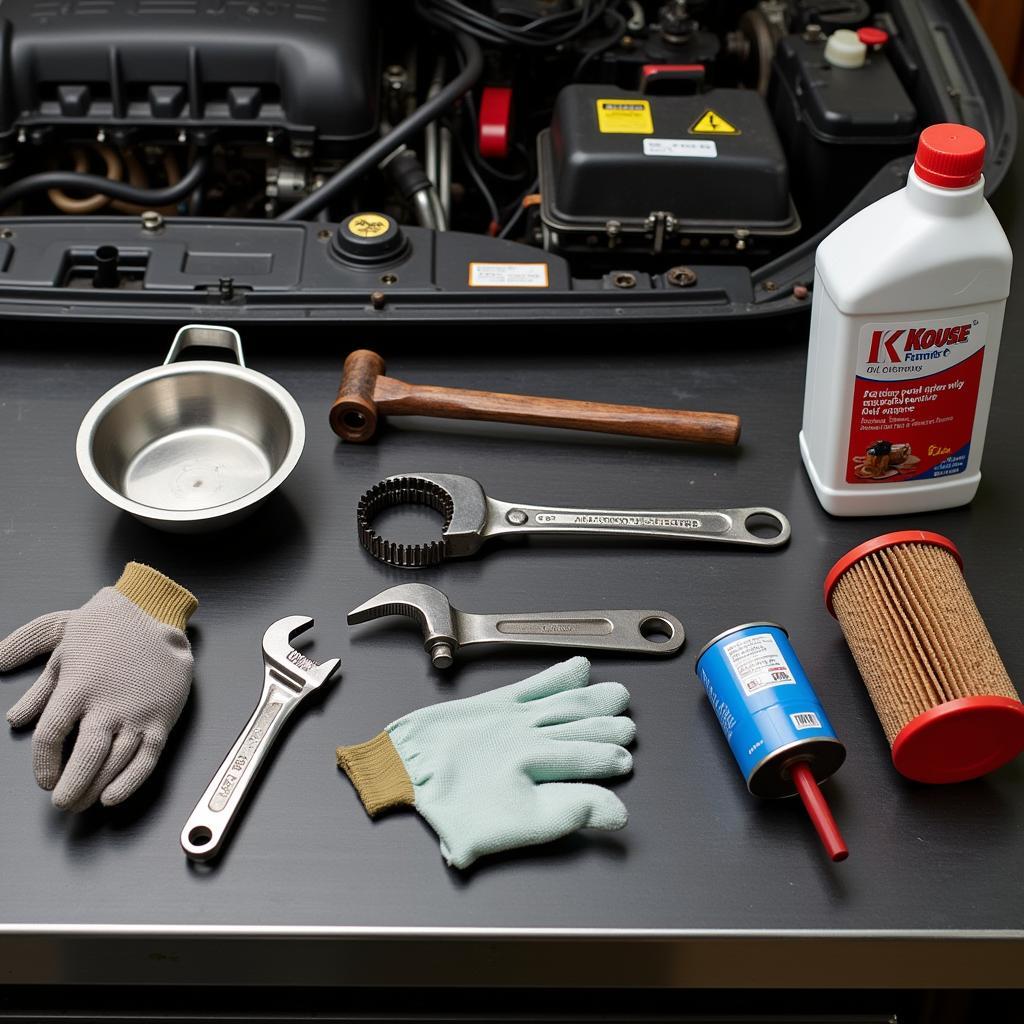Changing your car oil at home can save you money and give you a sense of accomplishment. But before you dive in, you need to gather the right tools. This guide covers everything you’ll need to change car oil at home, from the essential tools to optional extras that can make the job easier. Let’s get started! After reading this article, you will feel confident tackling this DIY project.
Essential Tools for a DIY Oil Change
Having the correct tools is crucial for a smooth and successful oil change. These are the must-haves:
- Wrench: The correct size wrench for your car’s oil drain plug is essential. Check your owner’s manual for the specific size.
- Oil Filter Wrench: This tool helps remove the old oil filter. There are different types, so choose one compatible with your car’s filter.
- Drain Pan: A sturdy drain pan is necessary to catch the old oil. Ensure it’s large enough to hold the entire capacity of your car’s oil.
- Jack and Jack Stands: Safety first! These lift and secure your car, providing stable access to the undercarriage. Never work under a car supported only by a jack.
- Funnel: A funnel helps prevent spills when pouring new oil into the engine.
- Gloves: Protect your hands from dirt and grime with a pair of disposable gloves.
- New Oil: Choose the correct oil viscosity for your car as recommended in the owner’s manual.
- New Oil Filter: A new oil filter is crucial for clean, efficiently flowing oil.
- Wheel Chocks: These prevent your car from rolling while it’s jacked up.
 Essential Tools for an Oil Change
Essential Tools for an Oil Change
Gathering Optional, but Helpful Tools
While the above tools are essential, these extras can make the job even smoother:
- Torque Wrench: This ensures you tighten the drain plug to the correct specification, preventing leaks and damage.
- Oil Filter Drain Tool: This tool minimizes mess when removing the old oil filter.
- Creeper: A creeper makes it more comfortable to work under your car.
- Rags or Shop Towels: Keep some rags handy for cleaning up spills and wiping down parts.
- Gloves: While mentioned above, having extra pairs of gloves is always a good idea.
Step-by-Step Guide to Changing Your Car Oil
- Warm up the engine: A warm engine helps the oil flow more easily.
- Secure the car: Engage the parking brake, chock the wheels, and lift the car with the jack. Place jack stands securely under the designated lifting points.
- Locate the drain plug: Consult your owner’s manual for the exact location.
- Position the drain pan: Place the drain pan under the drain plug.
- Remove the drain plug: Use the correct size wrench to loosen and remove the drain plug, letting the old oil flow into the pan.
- Remove the oil filter: Use the oil filter wrench to remove the old filter. Be prepared for some residual oil to spill.
- Install the new oil filter: Lubricate the gasket of the new filter with fresh oil and install it according to the instructions on the filter.
- Replace the drain plug: Once the oil has drained completely, clean the drain plug and install it, tightening it to the correct torque specification.
- Add new oil: Consult your owner’s manual for the correct amount of oil. Use the funnel to pour the new oil into the engine.
- Check the oil level: Use the dipstick to ensure the oil level is between the minimum and maximum marks.
- Start the engine: Run the engine for a few minutes and check for leaks.
- Dispose of old oil responsibly: Take the used oil and filter to a designated recycling center.
 Step-by-step Car Oil Change Process
Step-by-step Car Oil Change Process
Considering a new tool kit to enhance your DIY experience? Explore options such as the best tool kit for car repair. You might even find the homedepot european car tool kit helpful for specific car models.
Conclusion: Changing Car Oil at Home is Within Reach
Changing your car oil at home is a manageable DIY task with the right tools and a little know-how. By following the steps outlined in this guide, you can save money and keep your car running smoothly. Remember to always consult your owner’s manual for specific instructions related to your vehicle.
If you’re looking for ways to track your car’s maintenance, you may find a substitute care expense tool useful. Those concerned about skin care while working on their cars can explore the luxe studio skin care tool.
FAQs about Changing Car Oil at Home
- How often should I change my car oil? Refer to your owner’s manual for the recommended oil change interval.
- What type of oil should I use? Your owner’s manual will specify the correct oil viscosity for your car.
- How do I dispose of old oil? Take it to a designated recycling center or auto parts store.
- What happens if I don’t change my oil? Neglecting oil changes can lead to engine damage.
- Is it difficult to change oil at home? With the right tools and instructions, it’s a manageable DIY task.
Looking for resources to assess your elderly loved one’s needs? Consider checking out the elderly care assessment tool.
For any assistance, please contact us via WhatsApp: +1(641)206-8880, Email: [email protected] or visit us at 910 Cedar Lane, Chicago, IL 60605, USA. Our customer service team is available 24/7.

Leave a Reply